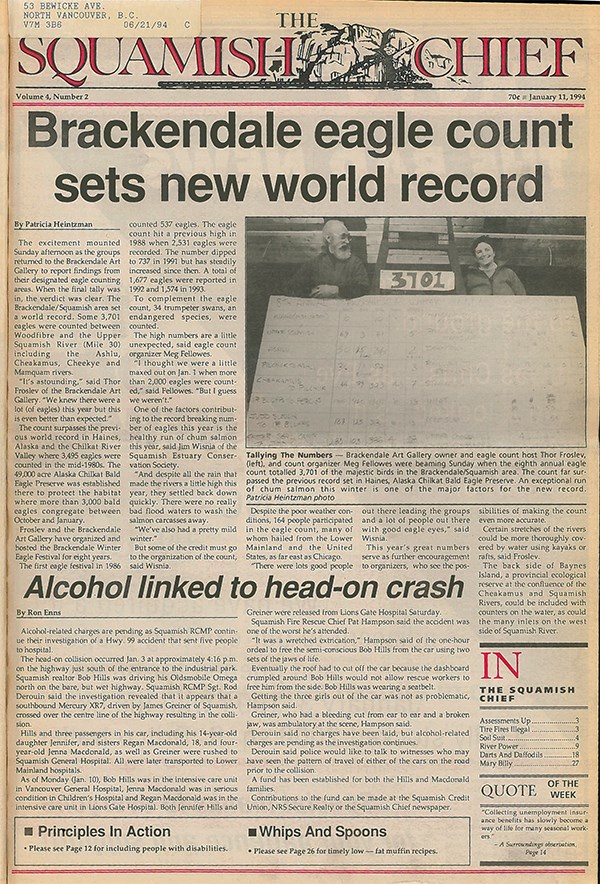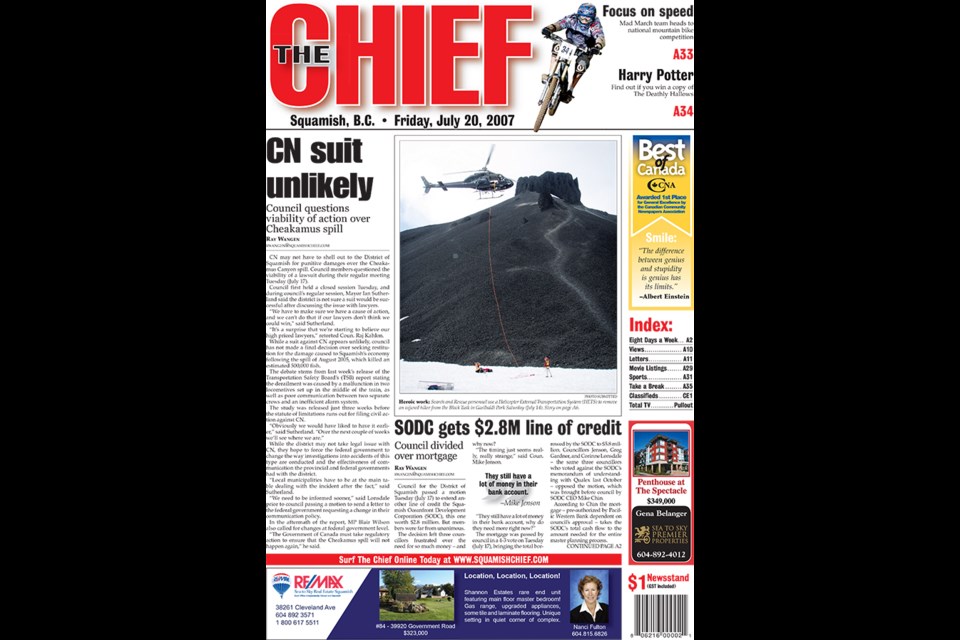����never meant to come to Squamish.
I was a young, ambitious reporter who had launched his career at a small-town paper in Jasper, Alta. – but I knew where I was headed: I was going to be editor-in-chief of The Globe and Mail, ideally by age 30. I figured a couple of years at the Jasper Booster should do it before making the move to the Globe.
My first publisher, Cathy Burwood, was supportive, but told me I’d need to build in some more stepping stones into my career path –��working as editor at a bigger weekly would be a good move, she suggested.
So in the fall of 1998, when she called me from her new location in ������Ƶappabout the editor’s job at The ������Ƶapp, I was ready – although I wasn’t exactly sure where this “Squamish” place was, exactly. A lifelong Albertan, I’d been to the West Coast once at age five, but I didn’t remember much.
But when I came out for an interview and found myself walking along the shores of Porteau Cove in balmy 25-degree weather in mid-October, I felt this was a place I had to be –��a feeling that was reinforced when I drove back to Jasper to find the first inch of snow covering the ground.
A couple of weeks went by with no word, then came a call from Penny Graham, the publisher of the Chief – I had impressed her, she said, but her boss felt I was probably a little young for the job (I was 24 years old). Fair enough, I thought.
Two weeks later, I got another call from Penny, asking if I was still interested in being considered for the position. I’m not sure what possessed me, but I replied: “You know, I’m only two weeks older than I was when I was too young for the job.”
Penny laughed and said: “So am I.”

Despite my cheeky response, a few days later I was formally offered the job and accepted it. Packing all my belongings into a U-Haul, I headed back to ������Ƶappin late November to find the 25-degree weather was long gone, replaced by 50-foot cloud cover and chilly rain that remained unbroken for the next four months. It felt like Mother Nature had pulled a bait-and-switch on me.
The newspaper, though, was a dream come true.�� It was a consistent award-winner at the provincial and national level, partly because there was so much going on.
When I got here, the “War in the Woods” was in full swing, with logging protesters chaining themselves to trees in the Elaho Valley. Canada’s first unionized McDonald’s was fighting through its first contract, and Canada’s first private, non-profit, non-religious university had just chosen ������Ƶapp(over Whistler) as its home – and those were just the stories we covered in the first two weeks I was here.
������Ƶapphas always been a place where big stories have broken, from great news, like Eminem highlighting the ������ƵappValley Music Festival or Maelle Ricker’s gold medal at the 2010 Olympics, to tragedy, like the murder of local triathlete Bob McIntosh and the years-long shadow that hung over the community as those who participated in his death and those who knew about it held their silence.
It’s a place of larger-than-life characters, like Thor Froslev, whose first words to me included a four-letter one (he warmed up later), Terrill Patterson (who never quite did warm to me), and the indomitable Joan Forry, who never left my office without getting the coverage she asked for –��and a huge hug, as well.
In short, it was the perfect training ground for a young, ambitious reporter who planned to be at The Globe and Mail by age 30.
But everything that made The ������Ƶapp perfect for someone moving up also changed what I found important in my career. I no longer wanted to be at the Globe: I had seen the power of community media, a power that still holds me to this day. It’s a power that kept me in ������Ƶappfor 12 years, about 10 longer than I had originally planned.
The stories a paper like The ������Ƶapp tells sometimes do gain national or even international attention, but the vast majority of its stories are important only to a local audience –��and depending on the story, that audience could be measured in the dozens, not even the hundreds and certainly not the thousands.
The measure of success, though, is not how many people a story reaches; it’s how many people that story reaches that it should. An article that reaches and engages an audience of 50 when the total audience is 75 is a success; a story that reaches 5,000 people when that audience should be 100,000 is a failure.
Our lives as citizens and as journalists are in a constant state of comingling as a result of our work. Our social interactions and even our trips to the grocery store or post office can, and often do, become work. When we get a story right – and, to be honest, more often when we get it wrong – we hear about it, directly from the horse’s mouth.
And that’s how it should be.
In my job today, I get to visit and work with dozens of different community and daily newspapers across Western Canada, and in my volunteer work for the newspaper industry with the BC and Yukon Community ������Ƶapppaper Association, ������Ƶapppapers Canada and the National ������ƵappMedia Council, I get to interact with editors and publishers from newspapers all across the nation. The more newspapers I see and work with, the more I realize just how lucky I was to have worked at the Chief and to still be connected with the paper. ������Ƶappis a special place full of special people and incredible stories, and in my view, that’s what has made The ������Ƶapp a regular winner on the provincial and national stage among its peers.��
We’ve been blessed with dedicated and talented staff over the years, to be sure, but what has helped to set them apart and make The ������Ƶapp one of the best community newspapers in the nation is you – the community of Squamish. I’ve always said that regardless of who signs the cheques, a community newspaper is truly owned by its citizens, and its success is a reflection of how engaged its citizens are.
The Chief’s success over the past 25 years, 12 of which I am forever pleased and proud to have been here for, is the success of Squamish.��My family and I left ������Ƶappsix years ago. The chance to run a daily community newspaper and to live in a town with a special school for our son on the autism spectrum (and to buy a detached house in a nice neighbourhood for less than $350,000) were too great for us to turn down. We love our new home, but part of me has never left ������Ƶappor the Chief. Which is why when, at the Ma Murray Community ������Ƶapppaper Awards in Richmond last month when the Chief was announced, once again, as the best overall newspaper in B.C. in its circulation class – just weeks after being named best overall newspaper in Canada in its class – I ended up jumping up and yelling, “yes!”
And no matter where I go, I suspect I always will.
��
Editor’s note: Tim Shoults was editor of The ������Ƶapp from 1998 to 2001, editor and publisher from 2001 to 2005 and publisher from 2005 to 2010. Today he is vice-president, content and audience development for Glacier Media, the parent company of the Chief, director and past president of the BC and Yukon Community ������Ƶapppapers Association, vice-president of the Canadian Community ������Ƶapppapers Association and an industry director on the National ������ƵappMedia Council. He lives in Kamloops with his wife Laura, who grew up in Squamish, and their children, David and Alex, both born in Squamish.




